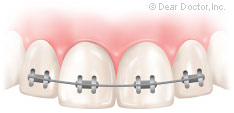The Field-Side Guide to Dental Injuries
A Guide for Parents, Athletic Trainers, Caregivers, Teachers and... Patients!
(Continued)
Urgent Treatment — Within 6 Hours
A painful injury for a tooth moved from its original position
Permanent Tooth
Permanent (adult) tooth injuries: Teeth driven into the jaw, extruded partially from the jaw, pushed out of alignment, root(s) fractured — While it is common sense that any dental injury should be treated as soon as possible for the comfort of the individual, it is less clear whether urgent treatment actually affects long-term outcomes of displaced teeth, crown fractures or fractured roots. Individuals usually see a dentist, oral surgeon or pediatric dentist within hours of such injuries and this is appropriate. Caregivers and parents are not used to seeing oral bleeding and this often drives the decision to go to a hospital/emergency clinic rather than attempt to contact their family dentist. However, a call to the dentist from the emergency room can be helpful in clarifying what treatment might be needed.
If a dentist is in attendance with a fully equipped dental emergency kit on hand s/he can freeze (numb) the teeth, move them back into place and splint them. If an athlete is stabilized this way s/he can complete the game without affecting long-term outcomes of these injuries.
 |
| Splinting joins loose teeth together helping to stabilize them. |
Why: Root fractures, intrusions, extrusions and teeth pushed out of alignment need to be treated by a dentist. The longer a tooth is left out of alignment the harder it will be to move it back into its original position due to formation of blood clotting in the socket. Severely intruded (pushed in) teeth may need to be extracted due to bone damage and almost all teeth in these categories will require splinting. Splinting involves joining loose teeth together to help stabilize them. A dentist can administer local anesthetic, reposition a tooth or teeth and place a splint at the sporting event or in a dental office a few hours later without affecting outcomes. Depending upon the injury the splint may stay in place between 10 days and 3 months.
Primary Tooth
Primary (baby or deciduous) tooth injuries: Pain and bleeding that accompany primary tooth injuries are often the reason for a rapid visit to a dentist and immediate attention. If a child is unable to bite and close the teeth together normally, call a dentist or pediatric dentist immediately.
Primary teeth however, can be treated within 6 hours without changing their long-term outcomes. Following treatment, analgesia (pain control) and a good night's sleep can often make the treatment much more comfortable and acceptable for young children who damage their primary teeth by falling or colliding while at play.

